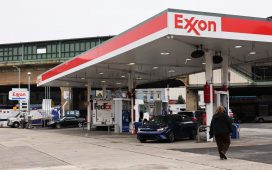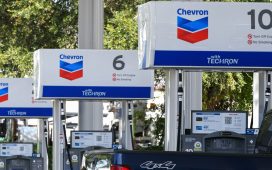Business and sing of landmark concept, Wall Street “WALL ST” sign over American national flags in front of NYSE stock market exchange building background. The New York Stock Exchange locate in economy district,
Getty
U.S. natural gas prices have collapsed since Memorial Day.
The prompt month NYMEX gas contract is down over 16% so far in June
Natural gas is at its lowest price level since May 2016.
Now around $2.20 per MMBtu, gas this time last year was ~$3.00.
Nobody saw this coming, especially when prices in mid-November spiked to nearly $5.00.
In addition, the ~$2.53 level had offered strong technical support for the past three years, making this collapse utterly unpredictable.
There are no contracts on the forwards curve above $3.00 until January 2024.
Technical support and resistance are now respectively at $2.10, $2.15 and $2.23, $2.28.
Yet, the RSI has fallen below 30, meaning the market is oversold and a limited rebound in price is expected.
Since Memorial Day, U.S. natural gas prices have plummeted.
Data source: CME Group; JTC
With the first day of summer last Friday, it has indeed been a very subdued start to the summer gas market.
Mild weather to say the least: seven weeks in, and five of them have been cooler than last year.
For the week ending June 15, U.S. weather was 32% cooler than last year and 15% percent cooler than normal.
Over the past few weeks, demand has been flat in the 75-80 Bcf/d range.
Interestingly, production has been level as well, fluctuating at 86-87 Bcf/d.
And such low prices obviously discourage bringing new output online, but I still expect us to surpass 90 Bcf/d in the coming months.
For reference, the biggest changes for this year’s gas fundamentals as compared to last are much higher domestic production (up 10%) and LNG demand (up 55%).
Other than those two, the other gas sectors are remarkably the same.
U.S. natural gas supply and demand are continually breaking records.
Data source: EIA; JTC
The U.S. gas storage deficit has therefore continued to drastically improve.
We had a 115 Bcf injection reported on Thursday, well above the concensus of 104 Bcf, pulling prices down further.
In fact, this marked the 12th consecutive above-average build for gas inventories and the seventh triple-digit build of the year.
By comparison, the last two injection seasons had only one triple-digit build each.
U.S. gas storage now stands 11% above where it was this time last year and 8% below the five-year average.
Just a few months ago, we were 33% below the five-year average.
The East and Midwest regions are respectively now just 2% and 5% below their five-year averages.
So at 2,203 Bcf of gas in storage, the deficit to the five-year average has fallen to just 199 Bcf, versus a 505 Bcf deficit back at the end of March when the injection season started.
The coming weeks seem bearish as well.
Expected coming injections stand at 99 Bcf and 84 Bcf, as compared to their five-year averages of 84 Bcf and 70 Bcf.
Yet, do not sleep on July and August: the summer heat is surely coming
The U.S. gas market should tighten a bit as we enter the hottest parts of the summer – although the upside is limited for now.
Gas-based electricity will be incentivized by low regional basis prices, and demand growth will also come from LNG and Mexican exports.
At 33% at the end of March, U.S. gas storage is now just 8% below the five-year average.
Data source: EIA; JTC








